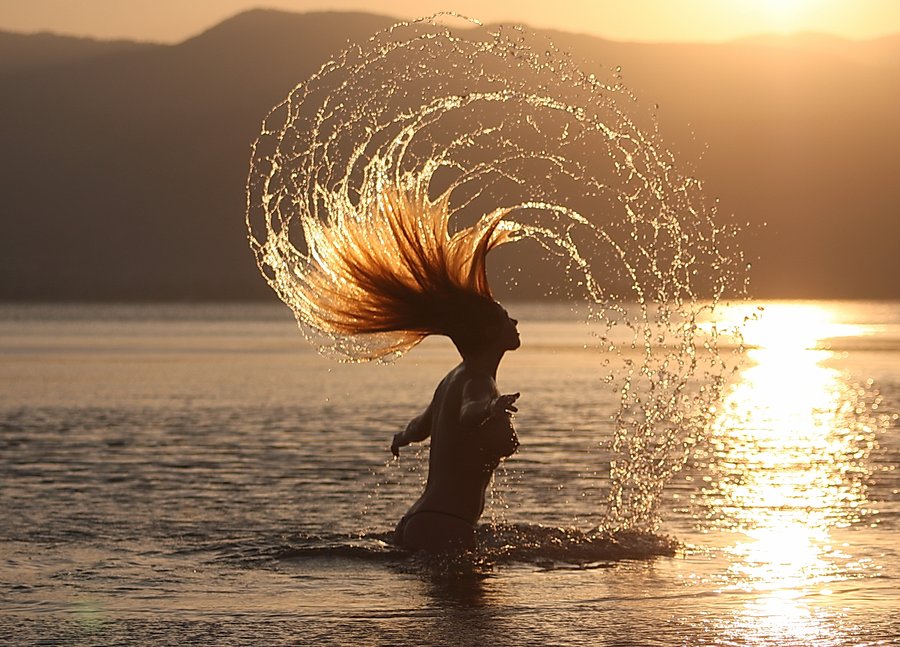Fit For SUN - Effects at human body and Whale
sun protection
is vital - for whales and corals as well as for water sports.
Reports on new findings from animal kingdom and human medicine.
You can turn and turn: Too much Sun on the skin is harmful, All the more on the water surface - and also for whales!
scientist of the Autonomous University of Querétaro in Mexico reported on sunglasses Sea-beetles, "of bubble-With different whales in areas With strong sunshine, "the Evolutionary biologist Karina Acevedo-Whitehouse. So far was not known whether and how protect the animals from UV radiation. But their team could now confirm, that whales as we humans sunscreen practice. In a broad-based Investigation on the Mexican Pacific coast and in the Gulf of California The marine biologists from 2014 to 2016 in 28 free whales and dolphins skin samples: Of blue whales, potties and fin whales, Big bottle nose dolphins, slender and spinner delines. Then they determined the strength Of melanin.
Their findings:
The sun also boosts the sun pigmentation in marine mammals. Example Blue whale - to the beginning of the year she with pale skin in the warm coastal waters of California and Mexico. Due to the stronger sunshine occur in the blue whale skin first UV damage before their skin cells adapt and - just as we humans - more melanin so as to avoid further DNA damages to protect. Over the next few weeks blue whales become much darker. Other Whale species, on the other hand, are quite different Sun protection strategies.
The researchers found that sperm whales have a body-specific repair mechanism. Pottwales are already darker by nature skin. They also stay much longer water surface, up to six hours at stronger UV-absorbing in their skin cells two repair genes activated to the DNA damage immediately. The topic of sun protection is always explosive. Although closes according to current status report from US researchers at the University Cambridge and Massachusetts Institute of Technology, our ozone layer, Largest natural radiation filter. The decline in CFC production, Covering decades of ozone in the stratosphere has come since 2016 now to a reversal of the process. Scientist forecast that the ozone hole by the year 2050. Quality news, because a functioning Ozone layer does not allow UV-C radiation and Much less UV-B radiation pass by.
Problem of long-distance trips
Because our leisure time has changed a lot: several trips a year and many more long-distance destinations are common today. Water sports enthusiasts and divers are much more attracted to far-off sun targets. There the sun exposure is reversed
A much stronger one than in the native waters. With all the consequences. The UV-A radiation of sunlight causes an accelerated aging of the skin. UV can also alter the genetic makeup of the cells and lead to white skin cancer or malignant melanoma, the black skin cancer. This leads to 31,000 new cases every year in Germany.
The diagnosis of white skin cancer here receives 234,000 people - per year. "White skin cancer is the result of chronic sun damage for many years," explains Prof. Dirk Schadendorf, director of Dermatological Oncology and Director of the Department of Dermatology at the Essen University Hospital. Dermatologists estimate that 70 per cent of the skin diseases occurring in older age are UV-induced. These include the precursors of skin cancer, of which millions of people are already affected in Germany, according to Professor Schadendorf.
Although you can treat it very well in the meantime - with a sunscreen, however, remains first choice. "Sun cream can also protect against white skin cancer if it is applied correctly," says Schadendam. However, too little is applied. New recommendations speak of a bottle of sunflower per person per holiday. Sun protection also includes spectacles with UV filters and wide hats in the tropics, but also thin snorkel and diving suits for tropical waters. Shaded spots are preferred, on the beach and on board safari boats.
Danger of water sports+
Water sports are particularly affected, at the beach, with the extensive snorkeling or at the boat exits to the diving spot. In addition, the sunscreen must be applied much more frequently after repeated drying after swimming, snorkeling or dipping, in order to achieve protection. As a rule of thumb, apply every two hours. Important to know: This does not, of course, extend the self-protection time. "Especially for water sports enthusiasts, the challenge is that the skin is not always dry, and the sun cream can not be distributed evenly on wet skin," says the skin researcher at L'Oreal, the company that was one of the world's first with Ambre Solaire in 1956 Sun protection series. Now in 2017, just 60 years later, there are even series developed for all water sports activities: La Roche-Posay has incorporated a completely new technology in a wet-skin gel, which is easy to apply on wet skin and reliably protects.
The WetForce technology from the Japanese manufacturer Shiseido is also made for long immersion and snorkel inserts: using a Ionic mineral sensor, solid bonds with the minerals are generated in water and perspiration, resulting in a highly water-repellent layer. Thus, the UV filters in the creams and lotion remain stable on the skin - even during prolonged immersion. Today, modern sunscreens are increasingly using mineral filters against UV-A and UV-B, and sometimes even with nano particles. The dermatologists used such mineral filters in the water-resistant, new Avene solar fluids: titanium dioxide and zinc oxide reflect the incoming light. These filters as well as the coating of the minerals with silicic acid and silicone guarantee a high light protection factor.
The minerals can also come from very natural sources: For the Clineral series, researchers from the Israeli AHAVA Dead Sea Laboratories extracted minerals from the Dead Sea into sun protection. But research does not stand still. For the water-resistant series A-DERMA Protect, an organic filter system was developed as an innovation: the filter Tinosorb M® absorbs the UV rays and converts them into energy. Further radiation is reflected like a mirror - a property which otherwise only has mineral filters, but Without white effect on the skin. Due to the high molecular weight of the filter, its particles remain on the skin surface and do not penetrate the skin barrier - an important question for critical consumers. And similar to sperm whale activating their repair programs, molecules from the young plants of the Rhealba Oat provide for an anti-oxidation cell protection of the human skin,
Corals also protect themselves
Sun protection from nature is a top theme: research into substances in ferns from mangrove forests and amino acids from algae and corals, such as at London's King's College. "We knew that corals and some algae would protect themselves against the intense UV radiation in the tropics with a self-proclaimed sunscreen. But until now, we did not know how to do it, "says Paul Long. They have now been able to investigate the biochemical processes with which corals produce their own sun protection.
The research focuses on the symbiosis between the corals and their co-inhabitants, unicellular algae, which use photosynthesis to produce nutrient-rich compounds for the coral. A lot of light is needed for this - one of the reasons why coral reefs often lie just below the water surface. However, since the UV radiation is still relatively high there, the algae still produce a kind of sun protection base stage, which they pass on to their host. The coral then transforms it into a substance which is protected against UV radiation. The coral sun protection is even transferable through the food chain: "We have seen that fish that eat these corals also benefit from this sun protection," says Paul Long.
If the coral substance could be produced in the laboratory, solar protection by means of a tablet would be feasible. In the meantime, there are attempts to reproduce these substances. "The filters are transparent, odorless and very stable and can therefore be used in creams," the Australian scientific authority CSIRO informed. According to CSIRO, the new sunscreen products are expected to reach market maturity in the coming years. Already active in skin care are other substances from the sea. Babor's SeaCreation series incorporates deep-sea proteins: the active ingredient combination is based on extracts of two microorganisms from the deep sea, Glycocéane GP3 and Babor thermophilus.
The substances should be highly effective against skin aging. In addition, the Green Caviar Algae was used. The green sun protection from nature is a top theme: research into substances in ferns from mangrove forests and amino acids from algae and corals, such as at London's King's College. "We knew that corals and some algae would protect themselves against the intense UV radiation in the tropics with a self-proclaimed sunscreen.
But until now, we did not know how to do it, "says Paul Long. They have now been able to investigate the biochemical processes with which corals produce their own sun protection. The research focuses on the symbiosis between the corals and their co-inhabitants, unicellular algae, which use photosynthesis to produce nutrient-rich compounds for the coral. A lot of light is needed for this - one of the reasons why coral reefs often lie just below the water surface. However, since the UV radiation is still relatively high there, the algae still produce a kind of sun protection base stage, which they pass on to their host. The coral then transforms it into a substance which is protected against UV radiation.
The coral sun protection is even transferable through the food chain: "We have seen that fish that eat these corals also benefit from this sun protection," says Paul Long. If the coral substance could be produced in the laboratory, solar protection by means of a tablet would be feasible. In the meantime, there are attempts to reproduce these substances. "The filters are transparent, odorless and very stable and can therefore be used in creams," the Australian scientific authority CSIRO informed. According to CSIRO, the new sunscreen products are expected to reach market maturity in the coming years.
Already active in skin care are other substances from the sea. Babor's Sea creation series incorporates deep-sea proteins: the active ingredient combination is based on extracts of two microorganisms from the deep sea, Glycocéane GP3 and Babor thermophilus. The substances should be highly effective against skin aging. In addition, the Green Caviar Algae was used. Te macroalge is known for its enormous nutrient density. The protein Glycocéane GP3 originates from the South Polar Sea and also transcends extreme cold in the depths. The extremely resistant microorganism activates the fibroblasts, which are responsible for collagen production. There are also new developments in technology:
There are first mobile UV checks for the smartphone. After typing the type of skin and location, you will display the maximum tanning time and other data. The "UV-Check" app was developed jointly by scientists from the German Aerospace Center and the Professional Association of German Dermatologists. A water-resistant skin sensor, which controls the individual UV exposure, also works with a smartphone: My UV-Patch is a sensor with photosensitive dyes on a transparent self-adhesive film. On the skin worn, the color changes according to UV intensity. Via the app of My UV Patch, he becomes the digital Baywatch assistant for water enthusiasts.










Comments